If you want to optimize your Google Ads account, don't overlook ad extensions! This feature gives you plenty of options to add more valuable information to your ads, which improves the user experience and multiplies conversion possibilities.
There are many different types of Google ad extensions, each with its own purpose and functionality. In this article we’ll breakdown each one, and explain how to use them for your ads. Let’s dive in!
l
What Are Google Ads Extensions and How Do They Work?
Think of Google Ads extensions as a kind of "extra" that allow you to add supplementary information to your ad, in addition to the title and description. Different extension formats include call buttons, location information, links to specific parts of the website, additional text, and more.

Extensions typically increase the number of clicks in an ad, as they improve visibility and offer interactive contact alternatives, such as calls or maps.
These are some things to keep in mind about how extensions work:
- They aren't always displayed. Google Ads selects which types of extensions to display for each individual Google search. That's why we recommend using all extensions that fit your business goals.
- The majority of extensions are configured manually. This means that the advertiser has to add them to the account. Although in some cases Google Ads will add extensions to text ads automatically when it thinks the extensions will have a positive effect on performance, like call or location extensions for example.
- The requirements for showing an extension next to your ad are: a) that the extension or combination of extensions has an expected positive effect on performance, and b) your ad's position and ranking are high enough.
- Adding extensions to your Google Ads ads is completely free. You'll be charged as usual for ad clicks, including clicks on extensions. The exception to this rule is clicks on seller scores, which are not charged. In total, you won't be charged more than two clicks for each ad impression, even if the user clicks multiple extensions.
- Extensions can be defined at the ad group, campaign, or account level, ensuring maximum flexibility.
Why Should You Use Google Ads Extensions?
They Increase the Visibility of Your Ad
Of course, adding more items takes up more space between Google search results, attracting the user's attention and increasing the chances of them clicking on your ad.
They Call for Immediate Action
Extensions can multiply the chances of interacting with your ad because they offer immediate and easy action for the user. For example, a call extension allows the user to immediately call the store directly. Ad extensions also offer more accurate information, such as the option to directly access a restaurant's menu without having to go through the home page or find their location on a map. All of these options boil down to more opportunities to generate conversions.
They Provide More Information to Users
"Classic" ads in Google Ads are limited to a title and description, providing limited space to explain what you offer. With extensions, you can communicate much better with your target audience.
They Improve Ad Rank and CTR
Extensions are included in the ad rank formula, so they help your ad position better relative to the competition. Also, as we explained above, ad extensions tend to have a positive impact on the percentage of clicks, which in turn increases the level of quality. In other words, using extensions with your text ads improves the performance of your account in general.
What Types of Google Ads Extensions Are There?
1. Sitelink Extensions
As its name suggests, sitelink extensions add additional links from your website to your ad. Each link is accompanied by two description lines.
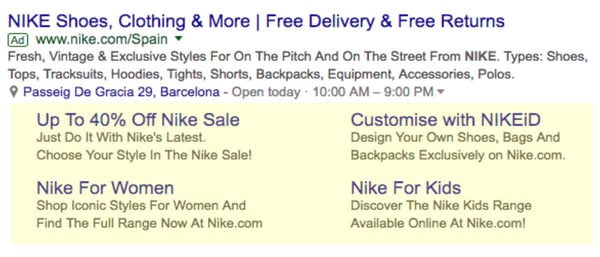
Its basic function is to add additional information and direct the user to the pages of greatest interest. For example, if you have a restaurant, you can add links to the menu page and the option to order at home.
The sitelink extensions are displayed differently depending on your device, ad position, and other factors:
- On computers: 2-6 links, on the same line or in two.
- On phones: up to 8 links on the same line, in carousel format.
The description may not be displayed.
2. Structured Snippet Extensions
Structured snippet extensions, shown in yellow below, highlight specific aspects of your products and services.
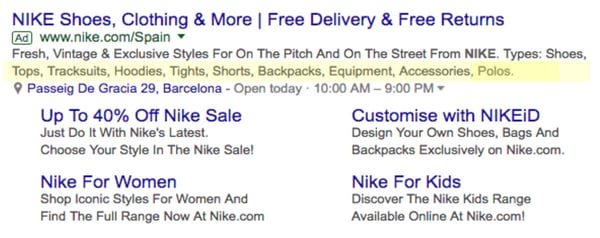
It consists of two basic elements:
- A headline to choose from a list of Google-predefined topics, such as "types", "models", or "destinations".
- A list of values, for example "pants, shirts, T-shirts, hoodies, dresses". Each value can be up to 25 characters long.
Unlike sitelink extensions, structured snippet extensions are not clickable.
3) Location Extensions
The location extensions are highly recommended for businesses with physical stores. They include the address and link to Google Maps with the location of the business, so that the user can purchase the product that interests them there.
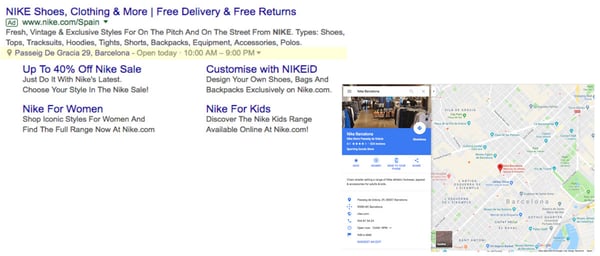
In addition to the store address, this extension may also include other data, such as opening hours, phone number, or customer ratings. It is also possible to add more than one extension in case you have multiple stores.
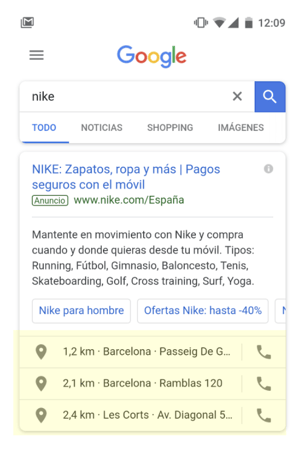
To be able to use location extensions, your account must be registered with Google My Business.
4. Callout Extensions
Callout extensions are used to display short, impactful text. They allow you to promote unique offers for users in a prominent way. Texts are limited to 25 characters each and are not clickable.
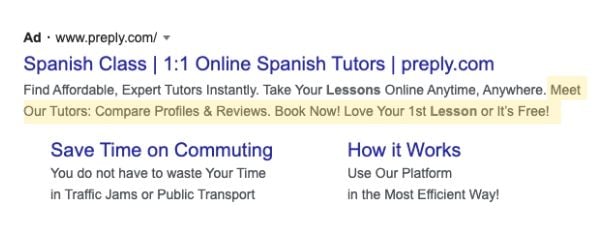
Featured texts are displayed organized into a single line or paragraph and separated by periods. Each ad can include between two and six. It's important to know that Google Ads decides in what order they're shown, so ensure the text makes sense independently.
-1.jpg?width=300&name=Disen%CC%83o%20sin%20ti%CC%81tulo%20(1)-1.jpg)
5. Call Extensions
Call extensions add phone numbers to your ads. Users can click the button and call your business directly.
.jpg?width=300&name=Disen%CC%83o%20sin%20ti%CC%81tulo%20(2).jpg)
Depending on the device they are displayed on, call extensions have different formats:
- On computers: Users will see a number.
- On phones: Users will see a clickable call button. Each call will be counted as a click on the ad.
If we use Google's forwarding numbers, we'll be able to record calls as conversions.
.jpg?width=600&name=Disen%CC%83o%20sin%20ti%CC%81tulo%20(3).jpg)
6. Price Extensions
Price extensions show the price of a specific product or service.
These extensions are displayed through a tab bound to the corresponding URL within the page. For example, if you have a hairdresser, you can create a price extension for cut and one for color, and direct users to the service's booking page.
We can set up to 8 price extensions for each ad, and they are displayed under text ads on computers and mobiles.
7. Promotion Extensions
The promotion extensions allow you to display special offers and discounts on ads. The link takes the user directly to the promotion page, increasing the chances of getting a conversion.
.jpg?width=600&name=Disen%CC%83o%20sin%20ti%CC%81tulo%20(4).jpg)
Some extensions are displayed below ads and have two lines of text to explain the characteristics of the discount.
The most interesting thing about this type of extensions is that you can set up promotions associated with occasions, such as "New Year" or "Valentine's Day". Each occasion has a predetermined promotional period. For example, New Year's ads can only be shown between December 1 and February 28. If you select any of these periods, it will be displayed as a bold label next to the promotion text.
8. App Extensions
The app extensions are specially designed to promote mobile app downloads. If the user clicks on the ad title, they will be directed to the website, while if they click on the app link, they will be directed to the app store.
App extensions have smart device detection, that is, if we create an extension for Google Play and another for the App Store, it will target the user that corresponds to it depending on the device you use. They also distinguish between types of mobile devices: for example, if the app only runs on tablets, users who are using a mobile phone will not be shown the extension.
Data Scientist en Cyberclick. PhD en Astrofísica por la Universitat de Barcelona con más de diez años de experiencia en investigación mediante el análisis e interpretación de datos. En 2019 redirige su carrera profesional hacia el mundo del Data Science cursando el Postgrado en Data Science y Big Data de la UB, así como participando en el programa Science To Data Science (S2DS) en Londres. Actualmente forma parte del equipo de Data Science y SEM de Cyberclick.
Data Scientist at Cyberclick. PhD in Astrophysics from the University of Barcelona with more than ten years of research experience through data analysis and interpretation. In 2019 he redirected his professional career to the world of Data Science by graduating in Data Science and Big Data from the UB, as well as participating in the Science To Data Science (S2DS) program in London. He is currently part of Cyberclick's Data Science and SEM team.

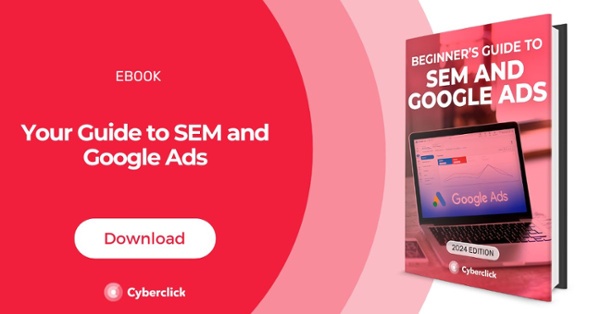



_%20Advantages%20for%20Marketing.jpg)
Leave your comment and join the conversation